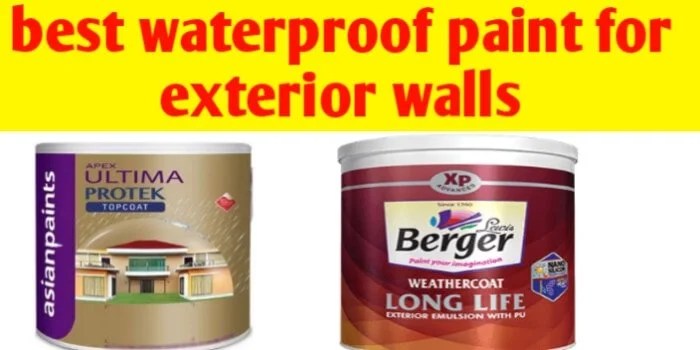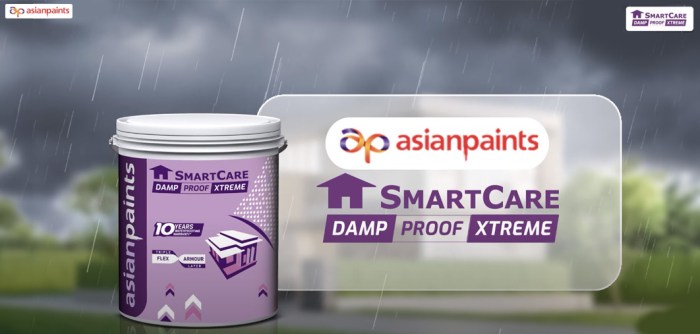Delve into the world of water proof exterior paint solutions with this informative guide. Discover the key benefits, differences from regular paint, and application techniques that will transform your surfaces.
Learn about the various types of waterproof exterior paint available in the market, the maintenance required to prolong its life, and tips for achieving a flawless finish.
Introduction to Waterproof Exterior Paint Solutions
Waterproof exterior paint is a crucial solution for protecting surfaces from water damage, especially in areas prone to frequent rain or humidity. Unlike regular paint, waterproof paint forms a barrier that prevents moisture from seeping into the surface, ensuring long-lasting protection.
Importance of Using Waterproof Exterior Paint
Using waterproof exterior paint is essential for maintaining the integrity of surfaces exposed to the elements. It helps prevent water damage, such as mold, mildew, and rot, which can compromise the structural stability of buildings.
Benefits of Waterproof Paint for Protecting Surfaces
- Prevents water infiltration: Waterproof paint forms a protective barrier that keeps water from penetrating surfaces.
- Enhances durability: By safeguarding against moisture damage, waterproof paint helps extend the lifespan of structures.
- Resists mold and mildew growth: The moisture-resistant properties of waterproof paint discourage the growth of mold and mildew, improving indoor air quality.
- Easier maintenance: Surfaces coated with waterproof paint are easier to clean and maintain, as they are less susceptible to staining and deterioration.
How Waterproof Paint Differs from Regular Paint
Waterproof paint contains special additives that create a water-repellent surface, unlike regular paint which may absorb moisture over time. Additionally, waterproof paint is designed to withstand harsh weather conditions and UV exposure, providing superior protection for exterior surfaces.
Types of Waterproof Exterior Paint

When it comes to waterproof exterior paint, there are different types available in the market to choose from. Two common types are oil-based and latex-based waterproof paints, each with its own set of characteristics and benefits.
Oil-based Waterproof Paint
Oil-based waterproof paint is known for its durability and resistance to harsh weather conditions. It provides a thick, protective coating that is ideal for areas that are prone to moisture and humidity. However, oil-based paints tend to take longer to dry and may emit strong odors during application.
Latex-based Waterproof Paint
Latex-based waterproof paint is easier to work with compared to oil-based paint. It dries relatively quickly, has low odor, and is easy to clean up with soap and water. While latex-based paints may not be as durable as oil-based ones, they are still effective at protecting exterior surfaces from water damage.Overall, oil-based waterproof paints are known for their longevity and ability to withstand extreme conditions, making them a popular choice for areas that experience frequent exposure to moisture.
On the other hand, latex-based paints are more user-friendly and offer a quicker drying time, making them a convenient option for DIY projects or areas that require regular maintenance.
Application Techniques for Waterproof Exterior Paint

When it comes to applying waterproof exterior paint, proper techniques are crucial to ensure a long-lasting and effective finish. From preparing the surfaces to achieving a smooth application, here are some key steps to follow:
Surface Preparation:
- Clean the surface thoroughly to remove any dirt, dust, or debris that could affect adhesion.
- Repair any cracks or holes in the surface using a suitable filler and allow it to dry completely.
- Sand the surface to create a smooth and even texture, ensuring better paint adhesion.
- Prime the surface with a suitable primer to improve the bond between the surface and the waterproof paint.
Proper Application Techniques:
- Stir the waterproof paint thoroughly before application to ensure a consistent finish.
- Use a high-quality brush or roller to apply the paint evenly on the surface, avoiding drips or streaks.
- Apply multiple thin coats of paint rather than a single thick coat for better coverage and durability.
- Work in small sections to maintain a wet edge and prevent lap marks.
Tips for Achieving a Smooth Finish:
- Avoid painting in direct sunlight or on windy days to prevent premature drying and uneven application.
- Follow the manufacturer's instructions for drying times between coats to ensure proper adhesion and durability.
- Clean your painting tools thoroughly after each use to maintain their quality and prevent clumping or streaking.
- Inspect the painted surface after it has dried to check for any imperfections and touch up as needed.
Maintenance and Care of Waterproof Exterior Paint
Proper maintenance and care of waterproof exterior paint is essential to ensure its longevity and effectiveness in protecting your surfaces from water damage.
Frequency of Reapplication
- For high-quality waterproof exterior paint, reapplication is typically needed every 5-7 years to maintain optimal protection.
- Lower quality paints may require more frequent reapplication, around every 2-3 years, to ensure continued water resistance.
Cleaning and Protecting Waterproof Painted Surfaces
- Regularly clean painted surfaces with a mild detergent and water to remove dirt, grime, and debris that can degrade the paint over time.
- Inspect the painted surfaces for any signs of wear or damage, such as peeling or cracking, and repair these areas promptly to prevent further water infiltration.
- Apply a fresh coat of waterproof paint to touch up any areas that have lost their water resistance, ensuring a seamless protective barrier.
- Consider applying a clear waterproof sealant over the painted surfaces to provide an extra layer of protection against moisture and UV damage.
Concluding Remarks

In conclusion, water proof exterior paint solutions offer a perfect blend of protection and aesthetics for your surfaces. With the right knowledge and care, you can ensure a long-lasting and beautiful finish that stands the test of time.
Commonly Asked Questions
How often should waterproof exterior paint be reapplied?
It is recommended to reapply waterproof exterior paint every 5-7 years to maintain its effectiveness.
Can waterproof paint be used on all surfaces?
Waterproof paint is suitable for various surfaces like wood, concrete, and metal, providing versatile protection.
What are the advantages of latex-based waterproof paint over oil-based?
Latex-based waterproof paint is easier to clean up, dries faster, and has lower volatile organic compounds (VOCs) compared to oil-based paint.









